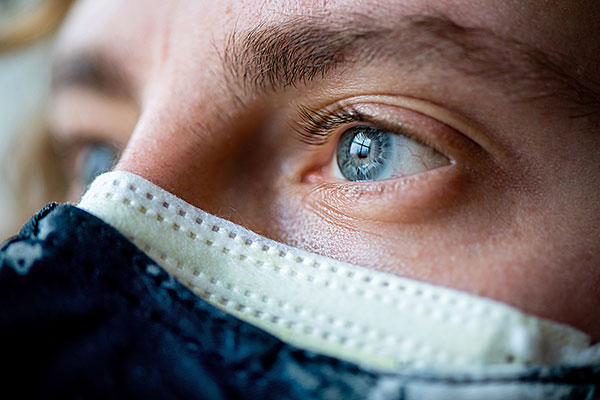How to Wear 2 Masks Effectively

CEE Assistant Professor Loretta Fernandez and Amy Mueller explain how to best wear two masks effectively to keep out COVID-19 particles.
2 masks are better than 1 to protect against new COVID-19 variants
Photo by Matthew Modoono/Northeastern University
As a new, more contagious variant of the coronavirus sweeps across the globe, so has a resurgence of interest in masks—which ones are safest, and how can people maximize protection with the resources they already have?
The verdict is in: Two masks are better than one.

Left to right: Loretta Fernandez, assistant professor of civil and environmental engineering and Amy Mueller, assistant professor of civil and environmental engineering. Photos by Matthew Modoono/Northeastern University
Layering surgical masks under cloth masks can decrease the amount of viral particles that reach the nose and mouth compared to using either mask alone, according to new research published in Cell Press. The surgical mask serves as the main filter, while the cloth mask improves the fit and adds a layer of filtration.
But there are some caveats, says Amy Mueller, an assistant professor at Northeastern who conducted research with associate professor Loretta Fernandez this spring to test which fabrics and styles blocked the most air particles from reaching the mask wearer’s face.
“Effectiveness is always a balance of these two factors: filtration efficiency and fit,” she says. In other words, doubling up on masks will only increase protection so long as the masks are still fitted snugly to the face.
“If you double up masks, same as if you add more fabric layers to a mask, you will increase the pressure needed to pull and push air through the fabrics,” she says. “This means you could end up pulling and pushing air around the edges of the mask if the fit is not sufficiently tight.”
In their research, Mueller and Fernandez found that adding a tight nylon layer on top of a mask increased the percent of particles blocked from the nose and mouth—but not because the nylon was adding extra filtration. “It was just making the mask tighter,” Fernandez says.
“If we started with a mask that was removing 50 percent of particles, adding a nylon layer to make the mask fit more securely to the face brought that same mask up to 75 percent of particles removed,” Fernandez said.
It seems a little counterintuitive that masks should be breathable, since the point of a mask is to stop the exchange of viral particles between people’s sneezes, coughs, spit, breath. But if air can’t penetrate through the mask, unfiltered air will enter and escape around the edges, defeating the purpose of the mask in the first place.
“If you’re huffing and puffing and you can feel air coming across your cheeks and the bridge of your nose, the air you’re breathing in and out isn’t being filtered. It’s just going around the mask,” Fernandez says.
While a snug fit should be top priority in a mask, the type of material is also an important consideration—some fabrics are “stickier” than others when it comes to trapping the viral particles, Fernandez explains.
First of all, the viral particles are hardly ever floating around on their own, she says. “They’re usually stuck to a dust particle or something like that.”
When those particles interact with the fibers of the mask, one of three things can happen: The particle can slowly and eventually drift toward the fibers and get stuck, the particle can “run into” the fibers directly and fuse with them, or the particle can actually be drawn to the fibers through an electric charge.
“An electrostatic force attracts the particle to the fiber. That’s how N95 masks work,” she says. “Any material that can carry a charge, anything that can make your hair stand on end, will work better than materials that don’t carry a charge.”
For example, masks made of wool, which tends to have a positive electrical charge, will perform better than masks made of cotton, which tends to have a neutral electrical charge, Fernandez says.
Being able to trap the virus in fabric fibers is great. But what should people do once the particles are stuck after a day’s use?
“People should definitely be changing their masks if they wear them for a long time,” Fernandez says. “Eventually they become drenched with exhalation. And if you keep breathing through that soggy mask, you’re going to be expelling water droplets through the fabric, and that’s the exact thing we’re trying to prevent.”
As for washing and replacing masks, the Centers for Disease Control and Prevention recommends washing cloth masks at least once per day and throwing away disposable masks after one use.
by Emily Arntsen – contributor, Northeastern University